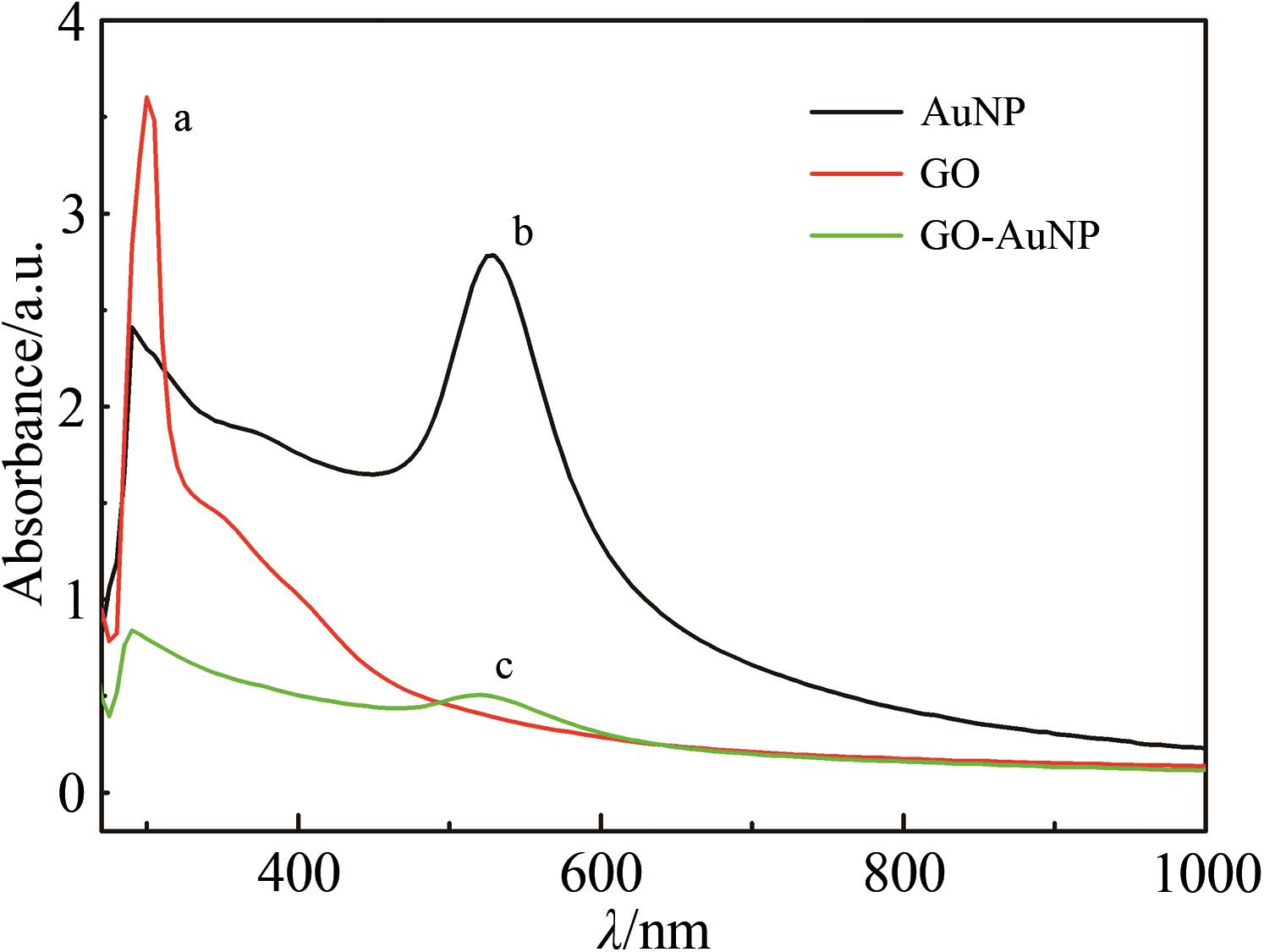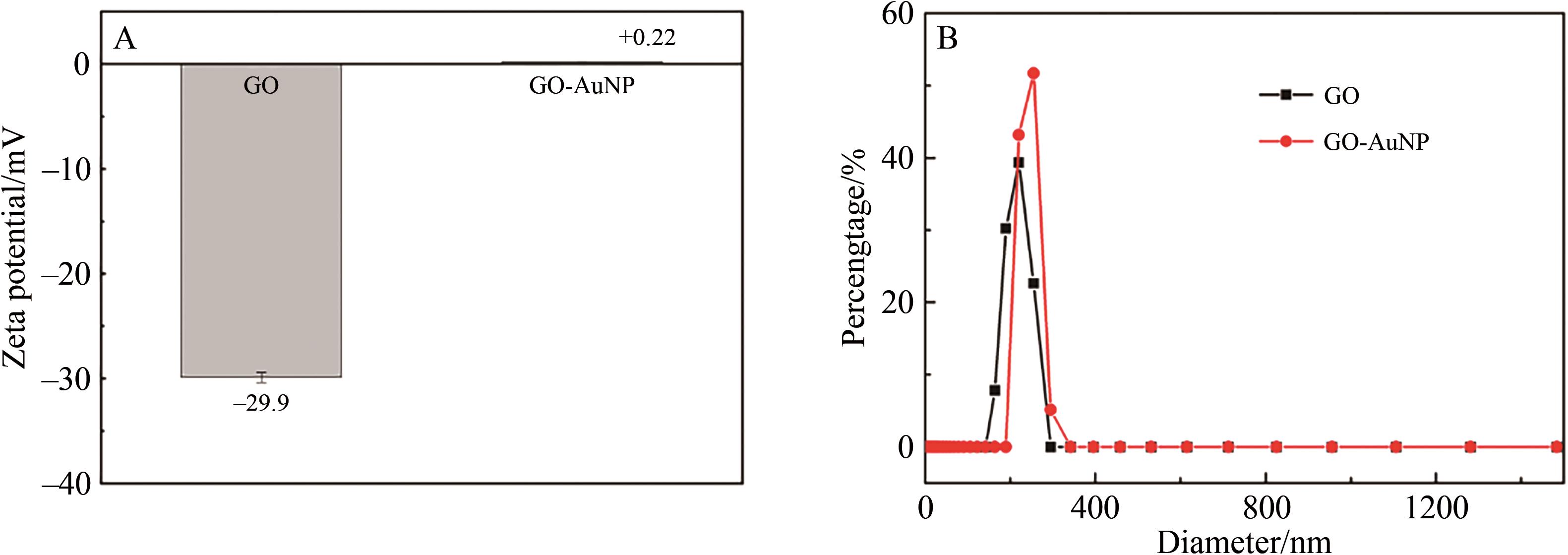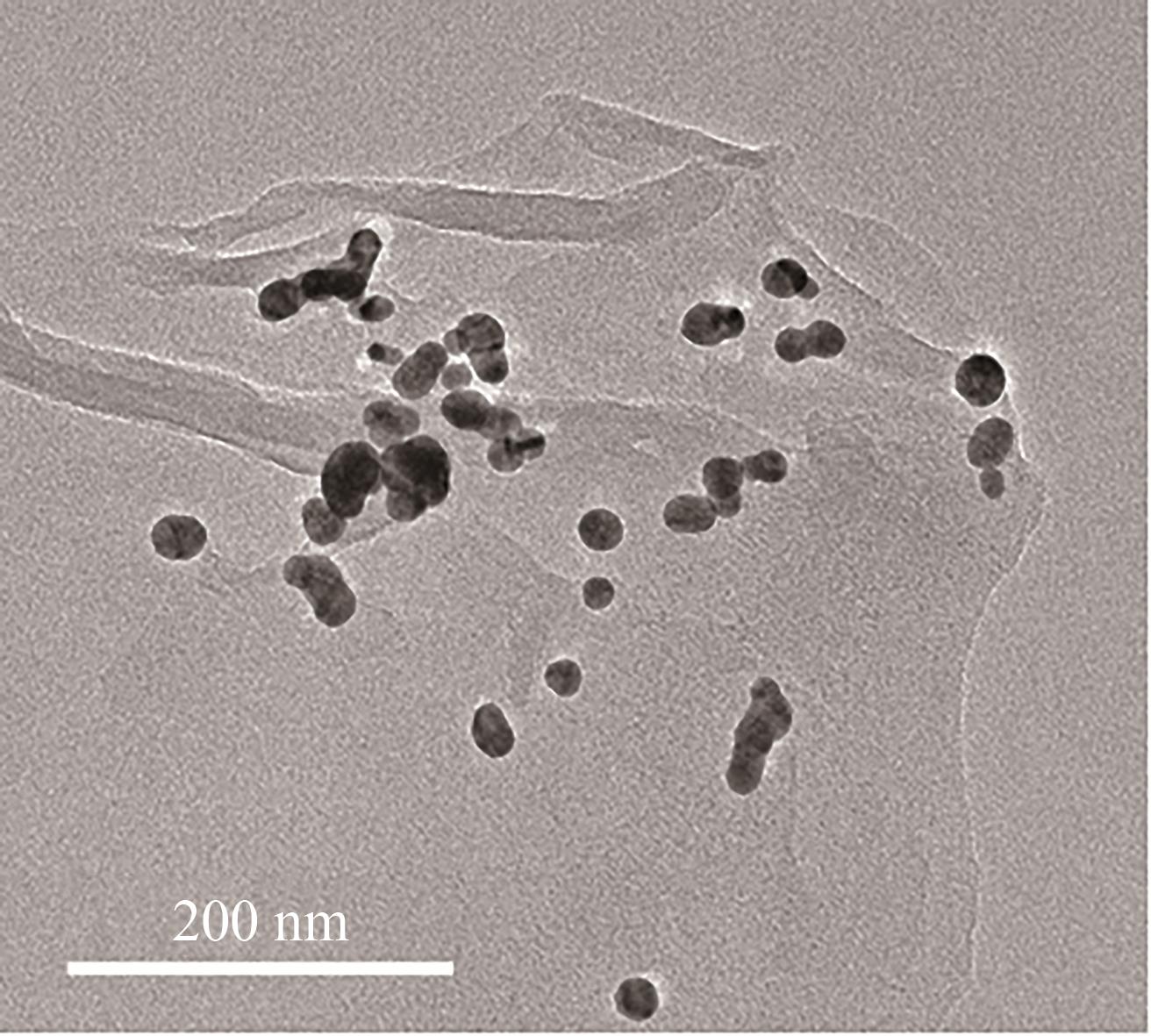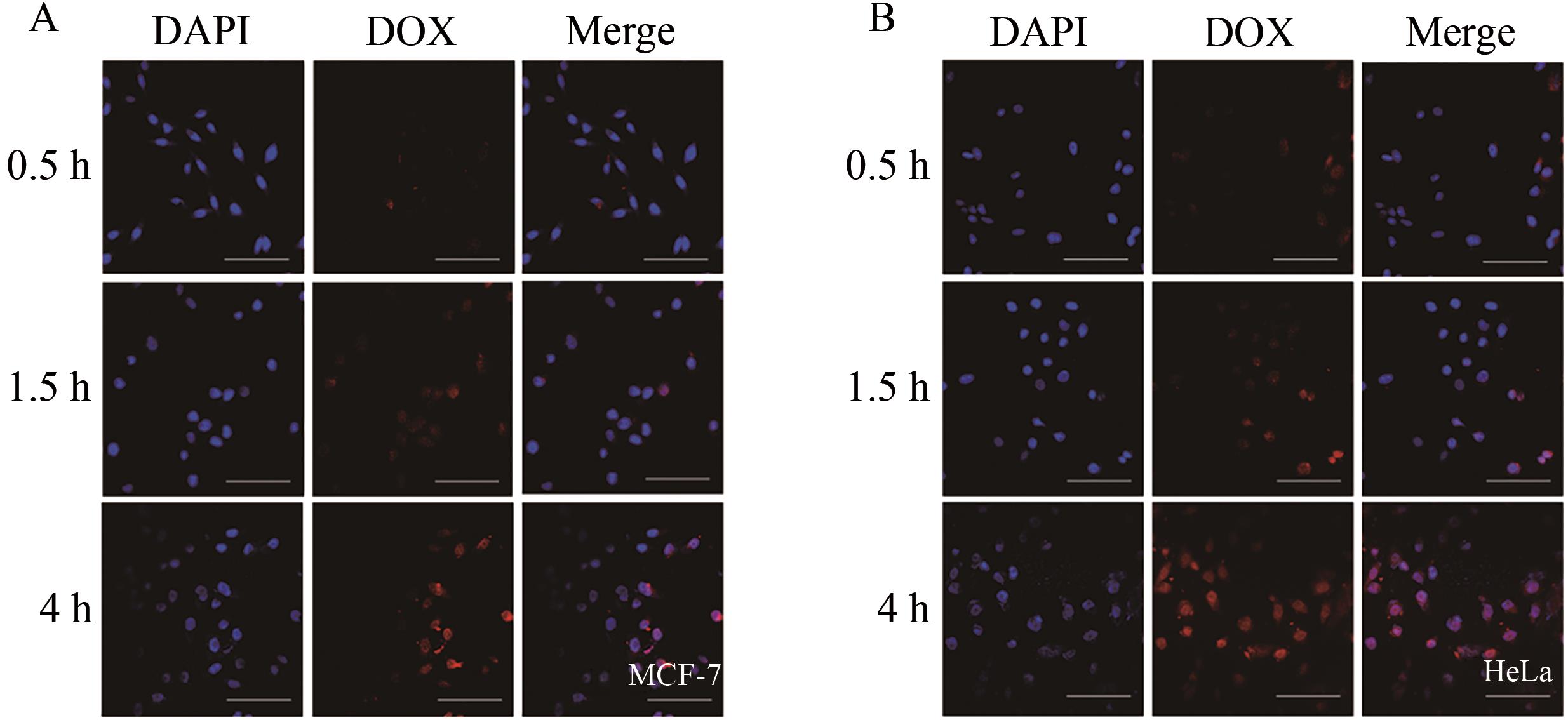
Chinese Journal of Applied Chemistry ›› 2024, Vol. 41 ›› Issue (7): 976-986.DOI: 10.19894/j.issn.1000-0518.230402
• Full Papers • Previous Articles Next Articles
Preparation and Anti‑Cancer Properties of Gold Nanosphere‑Graphene Oxide Nanodrug Carriers
Guo-Ying GUO1, Mo-Xuan ZHAO1, Wen-Ting LIANG2, Tao GONG1,2( ), Chuan DONG2(
), Chuan DONG2( )
)
- 1.Department of Biochemistry and Molecular Biology,Shanxi Medical University,Taiyuan 030001,China
2.Institute of Environmental Science,Shanxi University,Taiyuan 030006,China
-
Received:2023-12-28Accepted:2024-04-03Published:2024-07-01Online:2024-08-03 -
Contact:Tao GONG,Chuan DONG -
About author:dc@sxu.edu.cn
gyt830626@163.com
-
Supported by:the National Natural Science Foundation of China(21976113);the Natural Science Foundation of Shanxi Province(202103021224240)
CLC Number:
Cite this article
Guo-Ying GUO, Mo-Xuan ZHAO, Wen-Ting LIANG, Tao GONG, Chuan DONG. Preparation and Anti‑Cancer Properties of Gold Nanosphere‑Graphene Oxide Nanodrug Carriers[J]. Chinese Journal of Applied Chemistry, 2024, 41(7): 976-986.
share this article
Add to citation manager EndNote|Ris|BibTeX
URL: http://yyhx.ciac.jl.cn/EN/10.19894/j.issn.1000-0518.230402
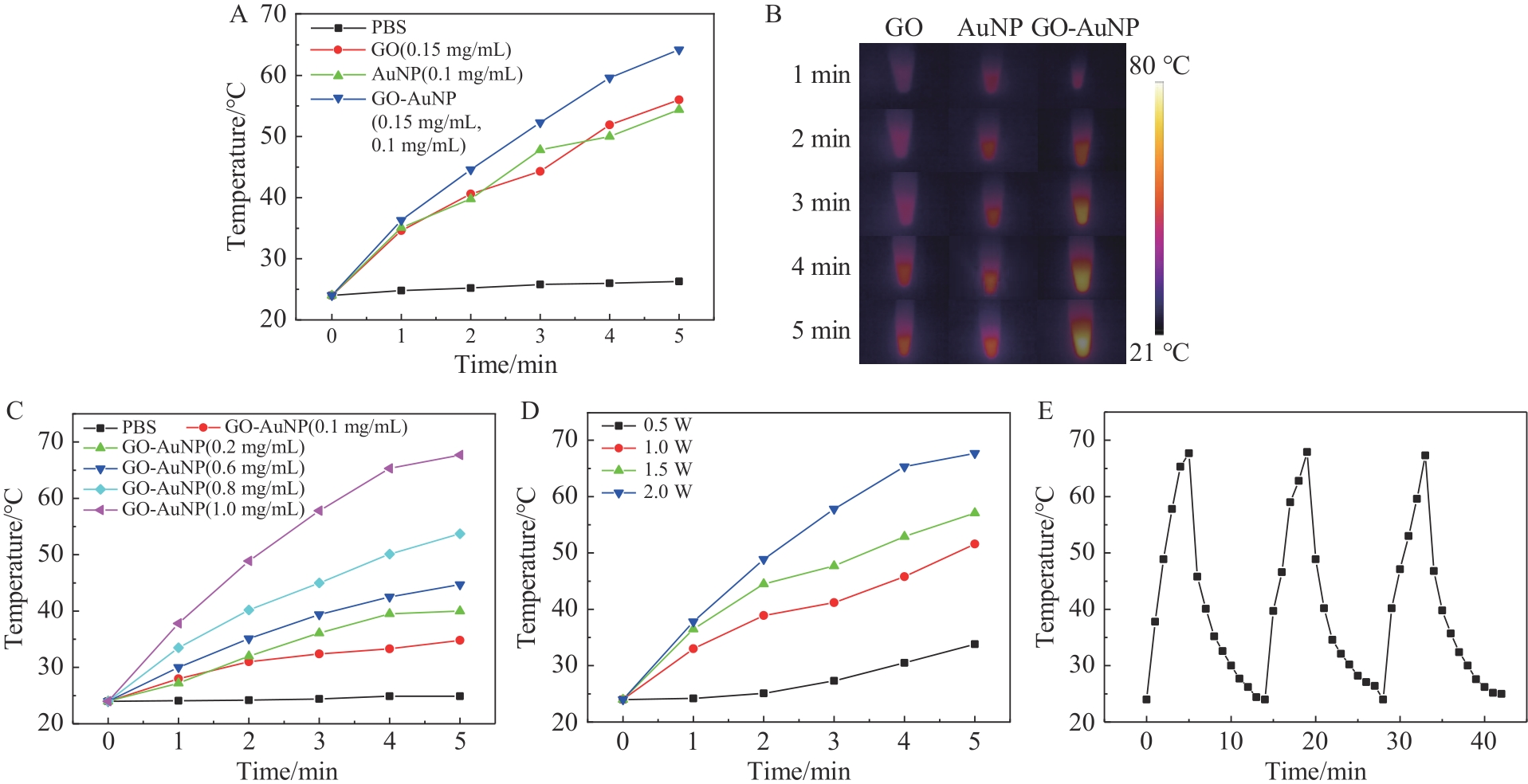
Fig. 5 Temperature change curves (A) and corresponding infrared thermal images (B) of different components of GO-AuNP under NIR irradiation(2.0 W/cm2); Temperature variation graph of GO-AuNP at different concentrations under NIR irradiation(2.0 W/cm2) (C); Temperature variation graph of GO-AuNP under different power NIR irradiation (D); Temperature cycle variation graph of GO-AuNP (E)

Fig.6 (A) The adsorption kinetic curves of GO-AuNP on DOX; Linear fitting graphs of the dynamic model for Lagergren's pseudo-first-order (B) and Ho's pseudo-second-order (C)
| Lagergern's pseudo?first?order kinetic model | Ho's pseudo?second?order kinetic model | ||||
|---|---|---|---|---|---|
| qe/(mg·g-1) | K1/h-1 | R2 | qe/(mg·g-1) | K2/(g·mg-1·min-1) | R2 |
| 24.64 | 0.027 75 | 0.987 6 | 41.07 | 0.001 700 | 0.999 7 |
Table 1 Parameters related to the drug delivery kinetics of GO?AuNP to DOX
| Lagergern's pseudo?first?order kinetic model | Ho's pseudo?second?order kinetic model | ||||
|---|---|---|---|---|---|
| qe/(mg·g-1) | K1/h-1 | R2 | qe/(mg·g-1) | K2/(g·mg-1·min-1) | R2 |
| 24.64 | 0.027 75 | 0.987 6 | 41.07 | 0.001 700 | 0.999 7 |

Fig.7 The isothermal adsorption curve of GO-AuNP on DOX (A); Linear fitting graphs with the Langmuir adsorption isotherm model (B) and Freundlich adsorption isotherm model (C)
| Langmuir isotherm model | Freundlich isotherm model | ||||
|---|---|---|---|---|---|
| qm/(mg·g-1) | KL/(mg·mL-1) | R2 | n | Kf /(mL·g-1) | R2 |
| 458.8 | 0.042 80 | 0.887 0 | 515.5 | 1.011 | 0.995 1 |
Table 2 Parameters related to the drug isothermal adsorption of GO?AuNP to DOX
| Langmuir isotherm model | Freundlich isotherm model | ||||
|---|---|---|---|---|---|
| qm/(mg·g-1) | KL/(mg·mL-1) | R2 | n | Kf /(mL·g-1) | R2 |
| 458.8 | 0.042 80 | 0.887 0 | 515.5 | 1.011 | 0.995 1 |

Fig.8 (A) Cumulative release of DOX from GO-AuNP@DOX at pH=5.3 and 7.4; (B) Cumulative release of DOX from GO-AuNP@DOX with and without NIR irradiation at pH=5.3

Fig.11 (a) Thermal imaging of tumor sites treated with PBS and GO-AuNP@DOX under NIR irradiation (808 nm, 2.0 W/cm2) for 0~5 min; (B) Tumor tissue images of mice under different treatment conditions
| 1 | DOLATKHAH M, HASHEMZADEH N, BARAR J, et al. Stimuli-responsive graphene oxide and methotrexate-loaded magnetic nanoparticles for breast cancer-targeted therapy[J]. Nanomedicine, 2021, 16(24): 2155-2174. |
| 2 | HAN H S, CHOI K Y. Advances in nanomaterial-mediated photothermal cancer therapies: toward clinical applications[J]. Biomedicines, 2021, 9(3): 305. |
| 3 | CHEN J Q, NING C Y, ZHOU Z N, et al. Nanomaterials as photothermal therapeutic agents[J]. Prog Mater Sci, 2019, 99: 1-26. |
| 4 | NGUYEN V D, MIN H K, KIM D H, et al. Macrophage-mediated delivery of multifunctional nanotherapeutics for synergistic chemo-photothermal therapy of solid tumors[J]. ACS Appl Mater Interfaces, 2020, 12: 10130-10141. |
| 5 | WEN C, CHENG R, GONG T, et al. Cyclodextrin-cholic acid-hyaluronic acid polymer coated Fe3O4-graphene oxide nanohybrids as local chemo-photothermal synergistic agents for enhanced liver tumor therapy[J]. Colloids Surf B-Biointerfaces, 2020, 199: 111510. |
| 6 | WANG X, MA Q, WEN C, et al. Folic acid and deoxycholic acid derivative modified Fe3O4 nanoparticles for efficient pH-dependent drug release and multi-targeting against liver cancer cells[J]. RSC Adv, 2021, 11: 39804-39812. |
| 7 | GONG T, WANG X, MA Q, et al. Triformyl cholic acid and folic acid functionalized magnetic graphene oxide nanocomposites: multiple-targeted dual-modal synergistic chemotherapy/photothermal therapy for liver cancer[J]. J Inorg Biochem, 2021, 223: 111558. |
| 8 | BEIK J, ALAMZADEH Z, MIRRAHIMI M, et al. Multifunctional theranostic graphene oxide nanoflakes as MR imaging agents with enhanced photothermal and radiosensitizing properties[J]. ACS Appl Bio Mater, 2021, 4(5): 4280-4291. |
| 9 | YANG L, KIM T H, CHO H Y, et al. Hybrid graphene-gold nanoparticle-based nucleic acid conjugates for cancer-specific multimodal imaging and combined therapeutics[J]. Adv Funct Mater, 2021, 31(5): 2006918. |
| 10 | 张雅静, 王晓辉, 徐亚娟, 等. 石墨烯纳米载药体系的制备及对肿瘤细胞的杀伤作用[J]. 应用化学, 2021, 38(6): 693-703. |
| ZHANG Y J, WANG X H, XU Y J, et al. Preparation of graphene nano-drug carrier system and its killing effect on tumor cells[J]. Chin J Appl Chem, 2021, 38(6): 693-703. | |
| 11 | 张雅静, 季鹏, 韩德明, 等. 石墨烯纳米载药体系的制备及对人口腔鳞癌细胞杀伤效果[J]. 应用化学, 2019, 36(5): 564-570. |
| ZHANG Y J, JI P, HAN D M, et al. Preparation of graphene nano drug-loading system and its killing effect on human oral squamous cell carcinoma cells[J]. Chin J Appl Chem, 2019, 36(5): 564-570. | |
| 12 | CHENG S J, CHIU H Y, KUMAR P V, et al. Simultaneous drug delivery and cellular imaging using graphene oxide[J]. Biomater Sci, 2018, 6(4): 813-819. |
| 13 | BLOISE N, STRADA S, DACARRO G, et al. Gold nanoparticles contact with cancer cell: a brief update[J]. Int J Mol Sci, 2022, 23(14): 7683. |
| 14 | 李铸衡, 马立娜, 刘殿骏, 等. 金纳米粒子的细胞毒性[J]. 应用化学, 2016, 33(9): 1009-1016. |
| LI Z H, MA L N, LIU D J, et al. Cytotoxicity of gold nanoparticles[J]. Chin J Appl Chem, 2016, 33(9): 1009-1016. | |
| 15 | HU W G, YAN Z Y, LI H M, et al. Development of a new colloidal gold immunochromatographic strip for rapid detecting subgroup a of avian leukosis virus using colloidal gold nanoparticles[J]. Biochem Eng J, 2019, 148(15): 16-23. |
| 16 | AL RUGAIE O, JABIR M, KADHIM R, et al. Gold nanoparticles and graphene oxide flakes synergistic partaking in cytosolic bactericidal augmentation: role of ROS and NOX2 activity[J]. Microorganisms, 2021, 9(1): 101. |
| 17 | GONG T, WANG X, ZHU H, et al. Folic acid-maltodextrin polymer coated magnetic graphene oxide as a NIR-responsive nano-drug delivery system for chemo-photothermal synergistic inhibition of tumor cells[J]. RSC Adv, 2023, 13(18): 12609-12617. |
| 18 | WANG C, HUANG L, SONG S, et al. Targeted delivery and pH-responsive release of stereoisomeric anti-cancer drugs using β-cyclodextrin assemblied Fe3O4 nanoparticles[J]. Appl Surf Sci, 2015, 357: 2077-2086. |
| [1] | Yue ZHANG, Rui LIANG, Can-Nan ZHAO, Chun-Mei LI. Construction of Graphene Oxide-DNA Nanoprobe for Adenosine 5-Triphosphate Detection and Drug Delivery [J]. Chinese Journal of Applied Chemistry, 2024, 41(1): 118-127. |
| [2] | Wei-Na HAO, Chao ZHOU, Hai-Ping DI, Lin-Hong DENG. Preparation and Characterization of Graphene Oxide-Hyaluronic Acid-Polyethylene Glycol Composite Supramolecular Hydrogel [J]. Chinese Journal of Applied Chemistry, 2023, 40(12): 1672-1681. |
| [3] | Fang XIA, Zi-Ying XU, He WANG, Yu-Fang HE. Graphene Oxide Characterization Based on Bibliometrics [J]. Chinese Journal of Applied Chemistry, 2023, 40(10): 1448-1455. |
| [4] | Yue-Hua ZHAO, Da-Peng WANG. Coadsorption Kinetics of Amino‑Functionalized Graphene Oxide and Fatty Acids at the Water/Oil Interface [J]. Chinese Journal of Applied Chemistry, 2022, 39(8): 1274-1284. |
| [5] | Shan SHAO, Jian ZHANG, Kai-Qiang DENG, Jie YANG, Shao-Ming YANG. Detection of Dopamine by Enzyme‑Free Sensor Constructed by Nickel‑Cobalt Bimetallic‑porphyrin Organic Framework Composites [J]. Chinese Journal of Applied Chemistry, 2022, 39(7): 1098-1107. |
| [6] | Qing-Fang NIU, Xin AI, Yi-Xuan WANG, Fang-Jiu HE, Bi LUO, Wen-Ting LIANG, Chuan DONG. Synthesis of Three‑Dimensional Reduced Graphene Oxide/β‑Cyclodextrin Complex and Its Electrochemical Detection of Levofloxacin in Water [J]. Chinese Journal of Applied Chemistry, 2022, 39(7): 1129-1137. |
| [7] | Yi-Xin XU, Shuang WANG, Jing QUAN, Wan-Ting GAO, Tian-Qun SONG, Mei YANG. Preparation of Molybdenum Disulfide Quantum Dots/Reduced Graphene Oxide Composites and Their Photocatalytic Degradation of Organic Dyes, Tetracyclines and Cr(VI) [J]. Chinese Journal of Applied Chemistry, 2022, 39(5): 769-778. |
| [8] | LIU Wen-Bin, YANG Sha-Sha, HUANG Guo-Lin, FAN Li-Jiao, XIE Yu-Ming. Synthesis of Phosphorylated Xanthan Gum/Graphene Oxide and Its Selective Adsorption of Uranium [J]. Chinese Journal of Applied Chemistry, 2021, 38(6): 658-667. |
| [9] | ZHANG Ya-Jing, WANG Xiao-Hui, XU Ya-Juan, LIU Wen-Shu, ZHAO Li-Hui. Preparation of Graphene Nano-Drug Carrier System and Its Killing Effect on Tumor Cells [J]. Chinese Journal of Applied Chemistry, 2021, 38(6): 693-703. |
| [10] | XIAO Haimei, CAI Lei, ZHANG Zhaohui, CHEN Shan, ZHOU Shu, FU Jinli. Preparation of Ion-Imprinted Polymers Based on Magnetic Graphene Oxide/MIL-101 (Cr) and Selective Adsorption of Cu(Ⅱ) and Pb(Ⅱ) [J]. Chinese Journal of Applied Chemistry, 2020, 37(9): 1076-1086. |
| [11] | GAO Siheng, YANG Yu, WU Jinling, QIN Lixia, KANG Shizhao, LI Xiangqing. Preparation and Photoelectric Performance of Graphene Oxide/Ultrafine Silver Composite [J]. Chinese Journal of Applied Chemistry, 2020, 37(8): 923-929. |
| [12] | ZHOU Zhuoyu, SUI Xiaochen, XIA Yongmei. Enzymatic Synthesis of Rubusoside and Its Inhibition on Liver and Gastrointestinal Cells [J]. Chinese Journal of Applied Chemistry, 2020, 37(7): 785-792. |
| [13] | WANG Wei, LI Juan, BAI Ru, HAN Zhen, FENG Xuewei, SUN Yue. Preparation of Au/Polyacrylamide@Graphene Oxide/Nano-palladium Electrode via Metal-Free Visible-Light-Induced Atom Transfer Radical Polymerization and Its Detection of Ethanol [J]. Chinese Journal of Applied Chemistry, 2020, 37(5): 595-603. |
| [14] | HUO ZhaoHui, YANG Xiaoshan, CHEN Xiaoli, ZHANG Gang, YIN Wei, CAO Manli, SHI Lei, QIU Yanxuan. Preparation of Ag/Two-Dimensional Graphitic Carbon Nitride/Reduced Graphene Oxide Composite and Its Photocatalytic Degradation of Antibiotics [J]. Chinese Journal of Applied Chemistry, 2020, 37(4): 471-480. |
| [15] | YU Zhiqiang, QU Jiangying, LI Jielan, ZANG Yunhao, GU Jianfeng, GAO Feng. Assembly of Graphene Oxide-Based Flexible Generator and Its Water Evaporation Power Generation Performance [J]. Chinese Journal of Applied Chemistry, 2020, 37(10): 1164-1171. |
| Viewed | ||||||
|
Full text |
|
|||||
|
Abstract |
|
|||||

